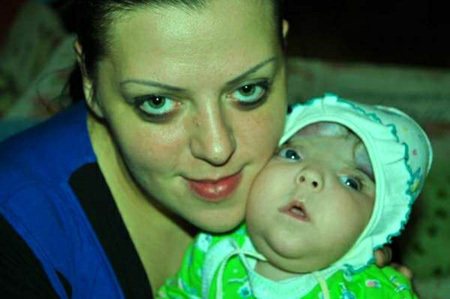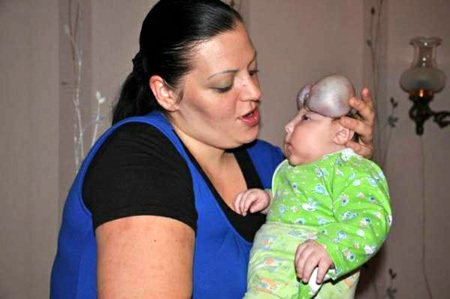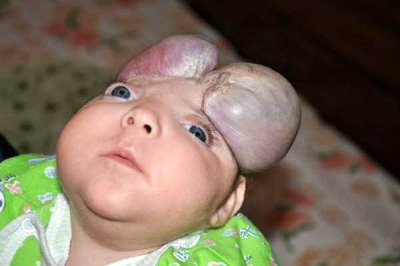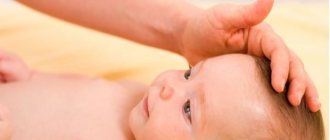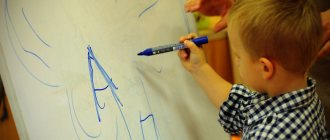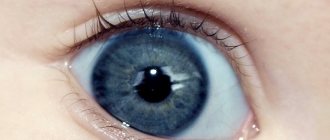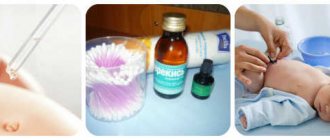Plagiocephaly - flat back of the head in a child
Babies are born with a soft skull to adapt to the demands of rapid brain growth in the first year of life. This feature makes the heads of small children easily deformed. The flattening of the head is called plagiocephaly. A flat neck (pictured) usually occurs when your baby sleeps in the same position or has problems with his neck muscles. The syndrome does not affect brain development in any way and does not cause permanent changes in the child's appearance and, fortunately, does not require surgical intervention. Typically, simple procedures such as changing the baby's position during sleep, holding him in his arms and playing on his stomach have a positive effect on gradually reducing the deformation of the skull.
Normal head shape in newborns
2-5 days after the birth of the child, the obstetrician measures from the line of the eyebrows to the occipital protuberance - the resulting value ranges from 32 cm to 38 cm.
There are 2 acceptable types of skull structure in a naturally born baby:
- Dolichocephalic form. Features – head elongated from the chin to the occipital region. Occurs in children born head first. If there are no other pathologies, the ovoid head returns to normal in a short time and does not affect the child’s health.
- Brachycephalic form. Flattened type of skull, the head is elongated from the forehead to the occipital region. Typical for breech presentation of the embryo.
After cesarean section, children's heads have a regular round shape. As a result of the negative impact of external factors in the first month of life, the baby develops dents or flattening on the head.
The normal head circumference of a baby after birth is 2 cm larger than the chest. By 4 months, these values become equal; at the age of one year, the chest indicator becomes 2 cm larger than the head. Babies born prematurely have a larger head compared to their chest.
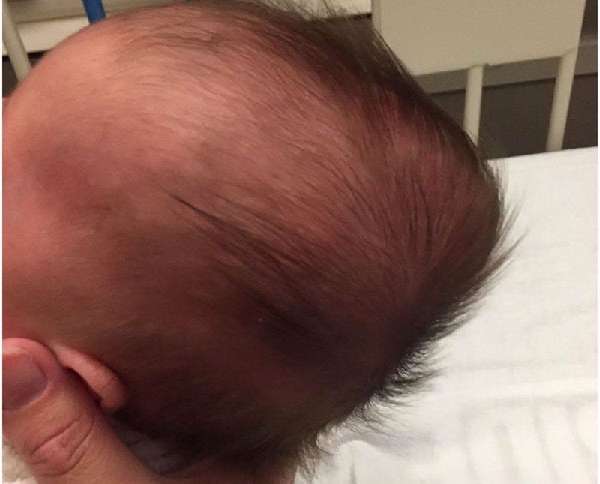
During childbirth, the baby may experience head deformation
As the fetus moves through the birth canal, a birth tumor may occur, which is swelling of the head. If there were no complications during childbirth, the formation is hardly noticeable and most often goes away within 6 days. In case of extensive swelling, an examination by a doctor is required.
Asymmetry of the skull can be complicated by cephalohematoma. The injury manifests itself in the form of a protruding lump and is caused by hemorrhage between the periosteum and the cranial bones. A common reason for the appearance is a discrepancy between the size of the baby and the size of the maternal birth canal. If the diameter of the lump does not exceed 2 cm, it will resolve within 2–3 months. If the lump is large, the intervention of qualified specialists is required.
Why is the back of the head flat?
The most common cause of changes in the shape of the back of the head is prolonged pressure on the bones of the skull during sleep. Because babies spend a lot of time lying on their backs, their heads can become misshapen. In addition, children may be placed in devices that require a reclining or semi-reclining position (car seat, stroller, some baby carriers, swings, etc.).
Babies born prematurely are much more susceptible to flattening of the head. Their skulls are even softer than those of babies born on time. In addition, due to their prematurity and medical conditions requiring a stay in the intensive care unit, they spend even more time lying in one position with limited ability to change it.
Flat head syndrome can appear in children even before birth if the skull is depressed by the pelvic bone or multiple sibling pregnancies. Indeed, in many cases, twin children are born with flat head syndrome. The position of the fetus in the uterus can also sometimes cause the head to flatten.
CHAPTER 11: WHY DOES MY CHILD HAVE THIS WRONG HEAD SHAPE?
Contents and other chapters of this book ON THIS PAGE
Most mothers don’t pay attention to this, don’t realize it, don’t notice. They accept their child as he is, love him and do not see any shortcomings. Friends and acquaintances, although they see this asymmetry, do not dare to talk about it, for fear of offending their parents or ruining relationships. But suddenly someone outside exclaims: “What a strange and funny shape of the head!” This could be a teacher in a nursery or kindergarten, or a random passer-by who opens a mother’s eyes to a small oddity or anomaly in the shape of her child’s head. From this moment on, this anomaly immediately catches my mother’s eye. She thinks only about her!
Moms ask me the same questions: “Why does my child have such an irregular head shape? For what reason? How could this happen?
I tell them that only in rare cases are the causes genetic or hereditary.
For the most part, the mechanism for the appearance of an abnormal head shape is associated with the position of the fetus in the womb and the process of childbirth.
In the womb, in the last weeks of pregnancy, the baby’s head “rests” against the mother’s stomach, which creates an asymmetry in the shape of the skull. Features of the structure of the maternal pelvis, the structure of the sacrum and the angle it forms, features of the birth process, these are the main reasons that influence the shape of the child’s head.
The natural behavior of a baby who has suffered during childbirth will be to seek a comfortable position to relieve tension in the tissues. He will tend to turn his head to the left or right, or throw it back.
(Very often, this position of the head is caused by congenital torticollis, which I call “false torticollis”, since it does not have all the clinical signs. In fact, this is an analgesic position in relation to the tension caused by cranial asymmetry. Therefore, differential diagnosis is very important, as how in each case the main treatment will be different. In case of true congenital torticollis, treatment is carried out by a kinesitherapist, and then by an osteopath (in that order) or both at the same time. In case of false torticollis, priority is given to the osteopath, who himself can get rid of this problem.)
What do parents do? When parents see that the child is lying on the same cheek, they allow him to do so, taking care of his comfort. Thus, with the “consent of the parents,” the child consolidates or aggravates the asymmetry of the skull. Let me remind you that the bones of the skull are very soft and flexible, and the skull is capable of deforming under its own weight.
What should parents do?
The work of an osteopath is necessary, but 80% of the success of treatment will depend on the parents. If the skull is severely deformed, the doctor cannot fix anything alone. A thirty-minute session once a week will not correct the situation if, in 7 or 15 days following the session, the baby lies in his favorite position and no one controls his position.
The success of the treatment will depend on three people. From the mother or nanny, the osteopath and the baby himself. I advise mothers to use a special device that allows the child to maintain exactly the position recommended by the osteopath. It is useful for up to 5 months. To begin with, they put it on during daytime sleep and make sure that the child does not throw it off until he gets used to it. From birth to one month, the child allows this to be done and maintains the position in which he is placed. From one to two months it is already more difficult. After three months this will become impossible, as the child will become very mobile.
The support device must fit snugly to support the head in the desired position. The child should not be able to move his head freely. Required for security reasons. For the baby to sleep on his back. But a lateral position is also possible if, as a precaution, the child is under constant supervision to avoid the slightest risk. In this way, it is possible to give a gentle position to the deformed side of the skull, thereby ensuring its correction.
When the baby is lying on his back, I advise mothers to encourage rotation of the head as often as possible in the direction opposite to the baby’s favorite. This can be done with the help of toys or by turning the baby 90 degrees from the stimulus toy.
If mom follows all my instructions correctly, then progress becomes obvious from session to session, even with pronounced asymmetries. The more diligent the mother is, the sooner the success of the treatment is visible, the fewer sessions are required for correction. In general, asymmetries can be corrected.
Mothers also ask the following question: “Is correction of skull asymmetry necessary only for aesthetic reasons?”
Of course, aesthetics should not be neglected, although hair will hide many of the irregularities of the skull. But not only asymmetry is the reason for a visit to an osteopath. And that's why.
The fundamental principle that should be followed is this: any asymmetry in one part of the skull is reflected in the entire head, which also becomes asymmetrical.
The head is not only the bones of the skull, it is also our sense organs, our receptors: eyes, nose, mouth, ears.
What is the connection between asymmetry and receptors?
Eyes. They are located inside two bony orbits, left and right. To ensure normal vision, at least a minimum of symmetry of one eye relative to the other is necessary.
Normal vision is impossible if there is a violation of the symmetry of the facial part of the skull. If correction is not made, the child may develop functional strabismus, hypermetropia, astigmatism or early myopia.
Ears. The ears are located on the temporal bones and should normally be symmetrical.
Dr. V. Fraiman writes that the axes of the temporal bones normally intersect at the level of the body of the sphenoid (the main bone of the skull) bone in the area of the sella turcica. When one ear is asymmetrical in relation to the other, this axis loses its central position.
The osteopathic concept says that imbalance creates the conditions for hearing impairment at a certain stage of life. I believe that such a damaging factor is the “cause of causes” for the occurrence of the so-called “primary lesion”, which can give rise to purulent otitis media, chronic otitis media, a violation of spatial orientation, in which the child becomes awkward and has poor control of his body. Other pathologies at the level of the ear, nose and throat may also appear.
Nose. Located along the central axis of the face. In fact, it consists of two parts, left and right, separated from each other by a partition. If the skull is symmetrical, the nose will be located strictly in the center, and its parts will function harmoniously. The harmony of function will be disrupted if the nose is displaced, i.e. the symmetry of the face will be disrupted. The central bone of the nose and its lateral partitions, being asymmetrical, will make it difficult for air to pass through the nose. The moisture content of the nasal mucosa will decrease. The bactericidal property of the mucous membrane will be less effective, which will lead to permanent sinusitis, rhinitis, nasopharyngitis, tonsillitis, otitis, etc.
Mouth. The oral cavity has a hard palate, divided into four parts. The oral cavity will also be affected by the asymmetry of the skull. If the left side of the palate is asymmetrical in relation to the right, then the symmetry between the jaws is disturbed and teeth bite problems arise. The swallowing process may be impaired. In 90% of cases, a child will be doomed to wear a special orthodontic apparatus or braces. Jaw deformation may occur and the jaw may shift to one side or the other. Over time, this can create problems at the temporomandibular joint level with difficulty opening and closing the mouth, clicking sounds when chewing, and yawning.
Spinal column. He also needs symmetry. The head rests on the first cervical vertebra. It is not for nothing that he bears the name Atlanta. On it lies the lower bone of the skull, the occipital bone. It is the occipital bone that suffers greatly during childbirth. It is she who is subjected to the strongest compressions, loads, and displacements. If the occipital bone is flattened, displaced anteriorly, posteriorly, to the right or left, or deviated from its central axis, that is, the balance is disturbed, all this will be reflected in the articular surfaces of the condyles with which the first cervical vertebra or atlas articulates. Atlas will try to compensate for the imbalance. It will adapt to imbalance. He is obliged to do this so that the person’s gaze remains horizontal and his head is placed straight. This is necessary for the semicircular canals of the inner ear, which provide balance to a person in motion.
All other vertebrae, both cervical, thoracic and lumbar, will adjust to compensate for the imbalance. False congenital torticollis and scoliosis will appear. For example, idiopathic scoliosis, i.e., scoliosis that does not have an obvious cause, may still have one: it can be triggered by “cranial scoliosis,” i.e., an imbalance at the level of the skull during childbirth.
That is why you should not ignore cranial asymmetry, mistakenly believing that this problem is associated only with aesthetics, and it will resolve itself - by itself or it will be covered by hair.
The skull and face are formed by the connection of many sutures and bones, which, articulating with each other, form an intelligent and coherent structure, homogeneous and functional.
It is quite obvious that the structure of the skull, due to its structure and shape, ensures the protection and functioning of everything that depends on it: organs, nerves, blood and lymphatic vessels. This is very important, since the senses and all sensitive receptors connect the newborn’s body with the environment. Vision, smell, hearing, taste and touch are senses that are directly or indirectly related to the totality of structures and functions of the head.
What should you think about the shape of the skull?
Here are three examples taken from my daily practice.
Example 1.
Some children have an asymmetrical skull without any noticeable abnormalities. They feel well, eat with appetite, and sleep normally. They behave calmly and develop correctly. Osteopathic tests are almost normal at every level. Despite the asymmetrical shape of the head, a relative balance is possible between structure and function. The baby is not in danger of any health problems in the near future. But what happens next? As a teenager or adult? Over time, it is possible that some ailments may appear, the roots of which go back to asymmetry that no one has eliminated. If you eliminate cranial asymmetry, you can avoid big troubles in the future.
Example 2.
Other babies have a relatively symmetrical skull shape. But osteopathic tests indicate dysfunction on many levels. This means that compensation and adaptation could not take place. This condition, whether large or small, disrupts the performance of certain functions. The baby may suffer from various minor health problems or ailments that cannot be classified as illness. In this case, with timely osteopathic treatment, it is easy to remove excess tissue tension and alleviate some symptoms and ailments.
Example 3.
And finally, newborns often have obvious asymmetry of the skull and its facial part. Osteopathic tests confirm the presence of osteopathic lesions. These babies have less mobility of some spinal joints at different levels, including the sacroiliac. There is compression of the cranial sutures and overlapping of the skull bones. The bones of the skull experience various types of deformation: flattening, curvature, asymmetry. The equilibrium of the mutual tension membranes is disturbed. Their deformations are visible at the level of the skull and especially in the facial part. The process of compensation and adaptation is absent or ineffective. There is over-excitability and irritation, or, conversely, a decrease or complete absence of some functions in terms of their output, efficiency and competence. Every minute these disturbances interfere with the calm flow of life of the baby and his parents. Such children constantly suffer. You should not hesitate to treat them. We need to start by “correcting the shape” of the head, the asymmetry of which is the root of all evil.
I would like to finish the presentation of this chapter by repeating the need for early correction and modeling of the skull, restoring its symmetry in the first days after childbirth.
To agree with this means to improve in yet another way the relationship between the structure and function of your baby and thereby lay a solid foundation in the building of your child's health.
A skull that does not have a certain level of harmony of shape, some motility and mobility of its structures and balance in membrane tension, may experience various kinds of ailments and disorders.
Continuation of the book: Osteopathy as an additional treatment to medical or paramedical treatment.
Tell friends:
Signs and symptoms
A flat nape in a baby is something that parents can easily recognize and notice. Typically the back of the head is flattened on one side and the amount of hair on that side is slightly less. Looking down at your baby's head, you may notice that the ear on the side that is flattened may be a little more protruding. In more serious cases, flattened head syndrome causes the head to develop a significant bulge on the opposite side of the flattened head and lead to an asymmetrical forehead in the baby.
Diagnosis

A doctor usually diagnoses a pars plana through visual assessment and observation of the patient. To detect torticollis, the doctor may observe how the baby's head moves and how he uses his neck muscles. X-rays and additional laboratory tests and studies are usually not needed. The doctor decides to monitor the child over several visits to observe changes in the shape of the head. If changes in sleeping position have a positive effect on the shape of the skull and the head begins to regain its round shape, then the problem is known to be plagiocephaly. If not, it may mean the deformity is the result of another condition called craniosynostosis.
Treatment
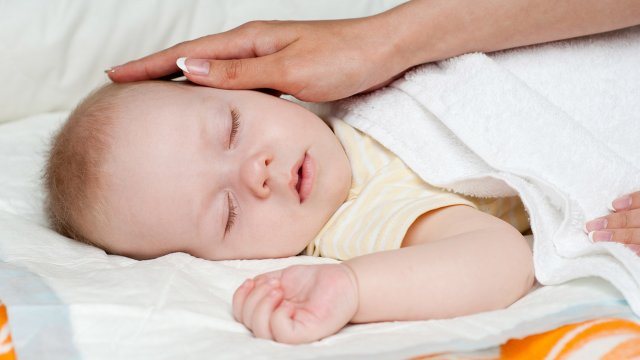
If your child has a flat head caused by one sleeping position, there are several ways to reduce further deformation:
- Change the position of your baby's head while sleeping. Move it from right to left and left to right when the baby is lying on his back. Even though he will toss and turn at night and change position, it is worth resting his head so that there is no pressure on the flattened side for at least some time.
- Carry the baby in your arms. Limit the amount of time your baby spends lying on his back or with his head on a flat surface (folding car seat, stroller, swing, etc.) Frequently pick up your baby and hold him in a position where his head can " rest” from the pressure.
- Encourage your baby to play on his tummy. Give him more tummy time when he's awake during the day. This position not only allows you to form and develop the muscles of the neck and back, but also has a positive effect on the development of the baby. The new perspective that the baby gains when looking from the belly position gives him impressions and allows him to find other aspects of the world around him. In addition, the tummy position strengthens the muscles of the neck and back, which will allow the baby to learn to rise and support the body with his arms. This in turn develops the muscles needed for sitting and crawling. Do not leave your baby unattended during tummy time.
- Physiotherapy and exercise. Your doctor may recommend physical therapy and exercises at home for torticollis. A physical therapist can show you exercises to do with your baby. Typically, these are stretching exercises that are gradual and progressive. Most will relax and stretch the neck muscles in the opposite direction of the contracture. Over time, your baby's neck muscles will stretch and the neck will straighten. Although the exercises are simple, it is very important to perform them correctly.
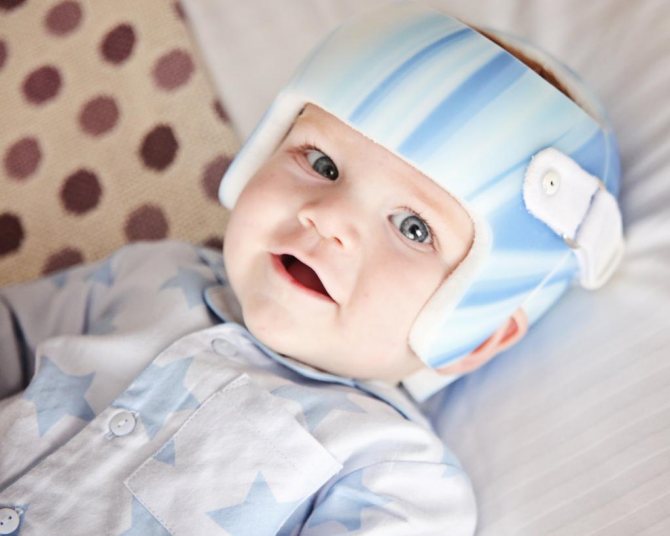
If the child has a very pronounced flat nape and the above methods do not improve the condition within 2-3 months, the doctor may prescribe a special helmet or a special shaping tape. However, helmets do not eliminate flat head syndrome in all children. A custom helmet works best when a baby is between 4 months and a year old, because then the baby grows faster and the skull bones are very malleable. The effect is that it puts gentle but constant pressure on the growing bones of the skull, causing them to assume a normal (rather than flattened) shape.
How to fix the deformation yourself
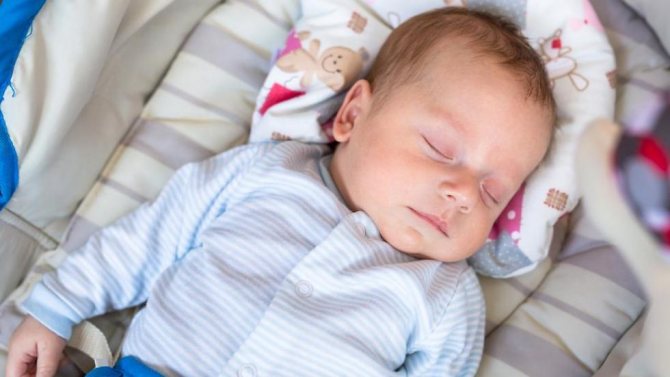
It is necessary to regularly change the position of the baby's head
Curvature requires mandatory monitoring and treatment. In the early stages, it allows you to get rid of the irregular shape by the first birthday. In most cases, depressions and bulges disappear within 2-5 months if the doctor’s instructions are followed.
The main condition for successful treatment is regular changes in the position of the newborn’s body during sleep and feeding. It is necessary to give the breast alternately, change hands more often when rocking. In a crib or stroller, you can switch to the other side once an hour. While awake, it is useful to carry the baby in a column, slightly supporting the head at the back of the neck.
A special orthopedic pillow in the shape of a butterfly gives a good and quick effect. Using “wings” from the sides, it holds the head in one position in the hollow. At the same time, the baby’s neck is supported, which is important for correcting torticollis and for injuries to the upper spine.
Modern methods include early learning to swim and wearing an orthopedic helmet at home. It forms the bones of the baby's skull without bulges, prevents the growth of individual areas, allowing the baby to move without restrictions. The procedure is painless and safe for the baby.
For various deformities, it is important to provide adequate nutrition to the child. The formula or breast milk must contain the required amount of microelements for the growth of bone tissue and nerve fibers. Anemia, which provokes oxygen starvation of the brain, should be excluded.
Orthopedic pillow for babies
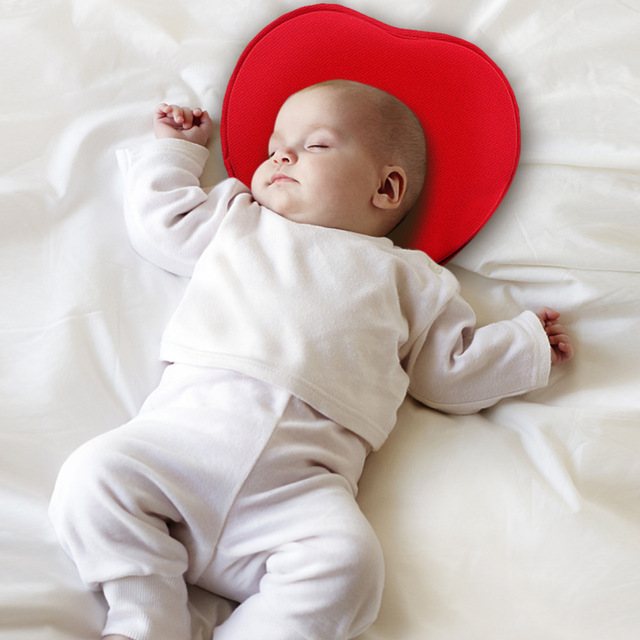
For small children, special orthopedic pillows can be useful. According to the manufacturers, this medical product is responsible not only for the prevention of skull deformation, but also for its treatment. As a preventative measure, the baby can sleep on a specially designed pillow from the first days. It is also suitable for babies born prematurely. Thanks to its unique properties, the pillow allows the head to naturally acquire a round shape while sleeping on the back.
It is enough to place your head in the deepening of the pillow to promote its correct shape day after day. This product is recommended for children with asymmetry and torticollis as an addition to therapy. It is also an excellent support for premature babies and children after surgery, when the child remains in one forced position for a long time. It does not restrict the baby's movements and allows the head and neck to move freely. When using it, there is no need to change the position of the baby. The only “requirement” is to place his head in the recess of the pillow.
A child was born without a skull in Ukraine
Seeing the boy, his own mother called him a freak
Anatoly BOROVSKY was lucky that his mother went for an ultrasound in the last stage of pregnancy, when it was too late to have an abortion. The baby was missing the top of his skull! Doctors were sure that the child would die during childbirth, but, contrary to pessimistic forecasts, he survived. Today Tolik is growing up in a foster family and, according to his new mother, is developing like an ordinary baby - smiling and even trying to crawl.
Having examined 25-year-old Irina with an ultrasound, Odessa doctors could not believe their eyes: this was the first time they had encountered such a pathology—the absence of a skull in a baby. At the same time, the woman was sent not for a caesarean section, but to give birth on her own, although the baby’s head could have been injured. Apparently, the doctors decided that the boy was no longer alive. A healthy baby weighing 2.5 kg was born with one peculiarity: between his brain and scalp there was only cerebrospinal fluid. The newborn resembled a fantasy character from the movie “Mars Attacks!”
- Hello, ass, New Year! — the obstetricians “greeted” the “alien.” Irina did not hide her disgust, refusing even to take the child in her arms. “This is terrible, a real freak!” — the woman explained the decision to leave her son in the maternity hospital. However, the unfortunate baby was lucky to find a loving family.
|
| Adoptive mother Anya... |
— Tosik spent two and a half months in the hospital. His mother showed no interest in him, his father - my nephew Vitya - went to prison. I constantly visited the child, he began to recognize me. He was sent to an orphanage, but I was indignant that I wouldn’t send him anywhere! - says Anna Puzanova , who sheltered the “Martian”.
A 31-year-old woman lives with her mother and two minor sons in a two-room apartment. She is raising her children without a husband. Bogdan and Alyosha loved Tolya like their own: they bathe the baby, walk with him, feed him, call him brother.
And Anna forgot what peace and sleep are. Due to damage to the central nervous system, the child has no thermoregulation: if you cover it, the temperature rises to 40 degrees, if you open it, it drops to 34. Every day, Tolik’s nails need to be cut off so that he doesn’t scratch his head. At first it was impossible to even wash it because of its thin skin. The boy often experiences convulsions, and to prevent him from choking on saliva, the use of a special apparatus is required.
“The doctors prepared me for the worst every day,” the adoptive mother smiles sadly. “They said he might die in his sleep.” That's why I was afraid to fall asleep...
|
| ...loves Tolik like his own |
Alone in the whole world
I haven’t shown Puzanov’s son to any doctors! Everyone shrugged helplessly.
— The boy has underdevelopment of the parietal bones; the brain is visible through the skin. Children with such pathologies, as a rule, are not born - this is a defect incompatible with life, explains Sergei Gorischak, . “Not a single such case has been recorded in the world, so there are no treatment methods.
According to doctors, for such children even a day to live is fantastic. Maximum - a week. And Tolik will soon celebrate nine months! The child is sociable, loves music, pronounces the first “ma”, “ba” and “dai”. But when he tries to move independently, the brain floats into his eyes, blocking his vision. However, there is hope for this baby too.
“They promised to help us in Singapore,” says Anna. — When Tosik turns two years old, he can have a skull reconstruction. The operation, which costs 120 thousand Singapore dollars (over three million rubles), will be carried out in several stages over three to four weeks; subsequently, a number of more procedures will be required. I hope that with the help of friends and caring people we will be able to collect the required amount.
|
| Tolik has no bones between his brain and scalp, only fluid |
Forecast for the future
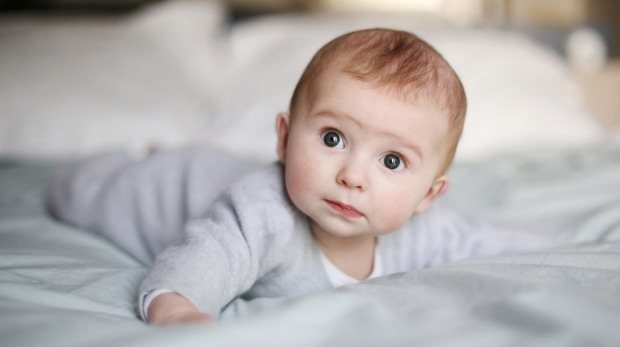
Parents of children with flat head syndrome should not worry because their future prospects are no worse. As babies grow, they begin to naturally change their sleeping position, much more frequently than in infancy, allowing them to change the position of their head. As a rule, over time, as the bones of the skull grow, even very significant changes disappear.
But there is also the possibility that the baby's head will never be completely symmetrical, but as a result of various developmental factors, the flattening will be almost invisible. Additionally, in later childhood the face gains greater clarity and attracts more attention than the rest of the head. The appearance of more hair and the fact that children are more energetic and mobile draw attention away from the shape of the skull. Experience and clinical trials show that a flat nape in an adult is not an aesthetic or sociological problem.
